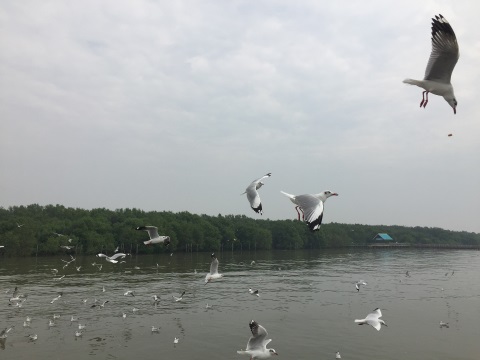| Back to Back Issues Page |
 |
|
Bangkok Travelbug Feb 2018 Seagulls of Bang Pu, Samut Prakarn February 04, 2018 |
| Hello
Bang Pu in history The Bang Pu Seaside Resort was constructed in 1939 by the Prime Minister Field-Marshall Plaek Phibunsongkhram (Prime Minister from 1938 – 1944) who intended it as a recreational area for the military. The key feature of the resort is a 400 m long pier (Saphan Sukta – Sukta Pier) extending out to the sea with a restaurant at the end of the pier. On land several houses were built for accommodation. Bang Pu found its place in Thai history before dawn on 8 December 1941. A battalion of the Japanese Imperial Guards Regiment landed at Sukta Pier. This was timed simultaneously with landings in Eastern Thailand, South Thailand, North-east Malaya and the attack on Pearl Harbour; it was the launch of the Burma and Malayan Campaigns. A small group of Police, Army Youth Corps and civilian volunteers from Samut Prakarn rallied to repel the Japanese incursion. The Prime Minister's decision at the last minute to allow passage rights of Japan troops in return for Japanese respect for Thai independence pre-empted a battle*. The noble effort by this small and brave group of men was nonetheless recognised and commemorated in a monument at the Bang Pu Seaside Resort, with a summary of the event engraved on the monument. 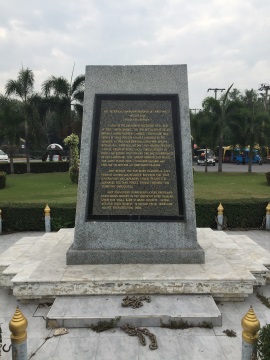
The World War II Memorial before the entrance to the pier For a similar situation in the south but with a different outcome, please see Battle of Ao Manao *Note: On 12 December 1941Thailand concluded a military alliance with Japan and on 25 January 1942 declared war on Britain and the USA. Contents Gulls in Thailand The Bang Pu Seaside Resort is also sanctuary for seagulls migrating from North Asia and Europe. Most seagulls or more correctly gulls as some species don't even live near the sea, are migratory. They fly across incredibly long distances before the winter months in the Northern Hemisphere to warmer climates in the south. From October to March the following year these birds flock to Bang Pu, making the place a favourite for bird watchers, photographers and visitors in general. 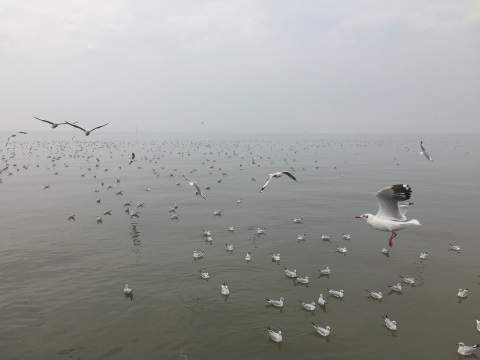
Safe and warm in their winter quarters The list of gull species in Thailand and their countries of origin will give readers an idea of how far they fly to get to Bang Pu. There are nine species of gulls in Thailand.**
**Source: Thai National Parks, list of birds from Thailand 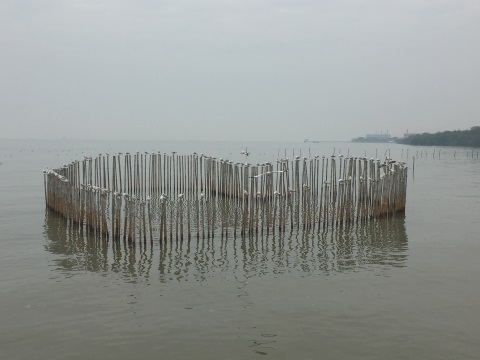
Gulls comfortably nestled on their stilts Besides gulls, other birds present at the Bang Pu bird sanctuary are the Little Cormorant, Little and Great Egrets, Javan Pond Heron, Collared Kingfisher, Black-winged Stilt and Whiskered Tern. Contents Viewing the Bang Pu gulls There are golf carts at the entrance of the Sukta Pier to take visitors to the end of the pier. Though I recommend that if you can, take a walk in. Here's why. As we passed the mangrove along shoreline on the left side of the pier, I chanced upon these scenes. 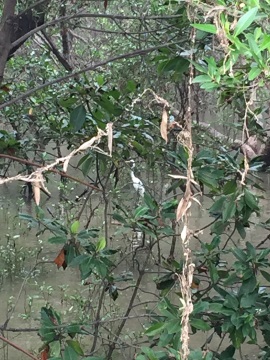
Notice the white, long-legged feathered friend among the mangrove, I don't know what's the species 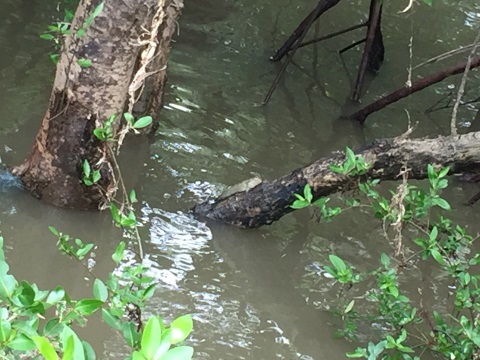
Mudskipper# climbing on the branch of a mangrove plant #Note: Mudskippers are amphibious fish, their pectoral fins at the sides of their bodies act like legs that enable them to walk when they are out of the water 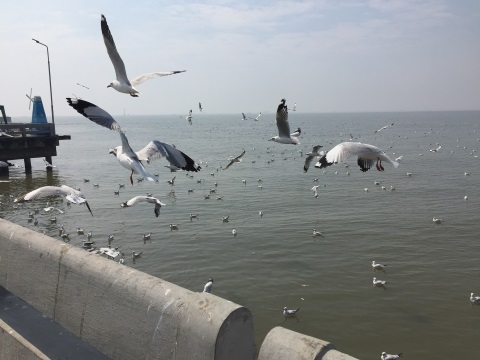
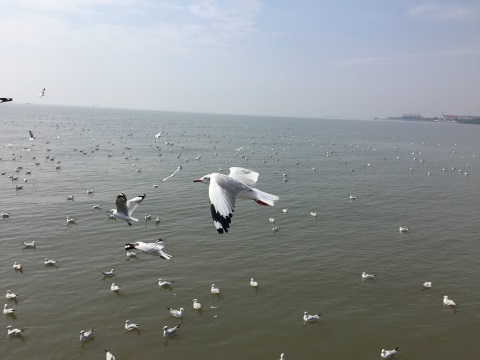
Stroll along the pier and walk among the birds The gulls assemble in huge flocks and float around peacefully on both sides of the pier. They seem to have their own flocks and don't mix with others. 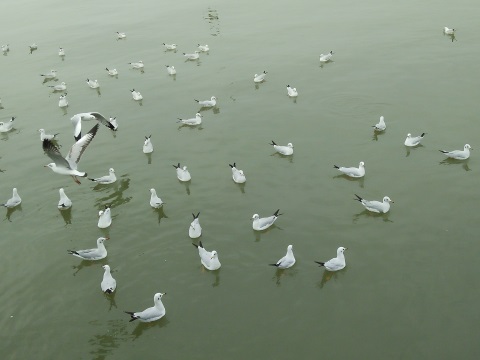
Gulls at rest Other gulls will fly around near the pier and this is where it gets interesting. Buy some bird food from the vendors to feed the gulls. Please don't throw the food on the pier, throw it in the sea where it will be instantly snapped up. 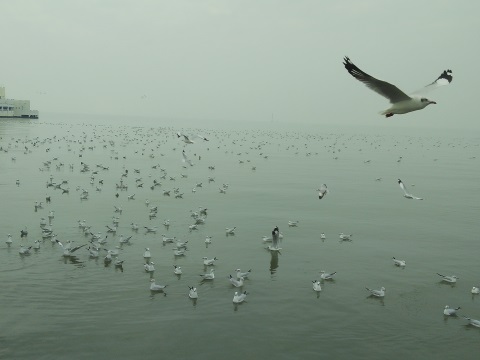
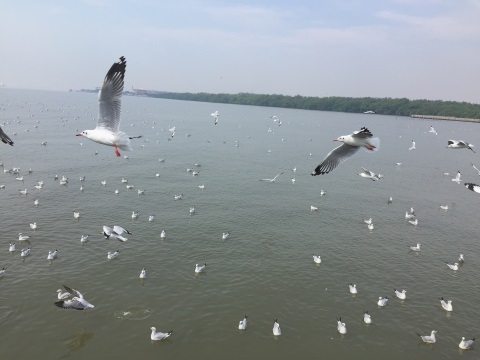
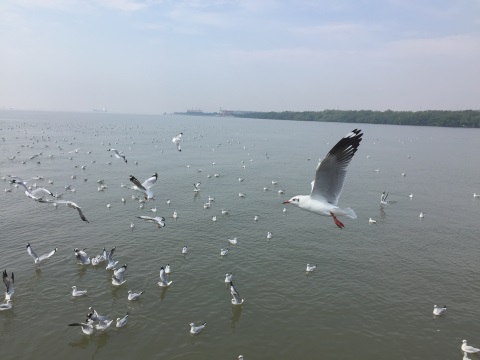
Watch the gulls go swooping by Or throw the food up in the air over the sea. If you time your throw well with the flight of the gull, it'll snap up the food in mid-air! 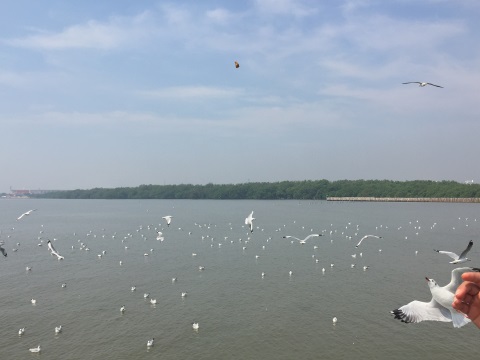
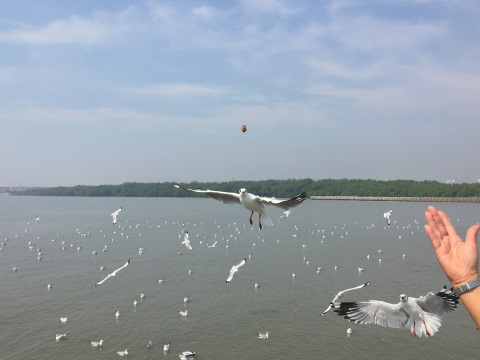
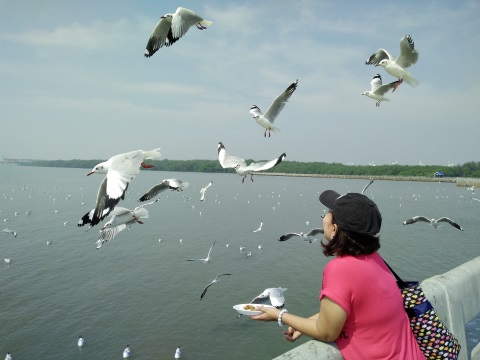
Time your throw and watch the gulls snap up the food in mid-air I wouldn't recommend placing the piece of food on the palm of your hand, it's a bit risky, you might get nipped. After a long walk, visit the shops at the end of the pier and have lunch in the restaurant if you like. There's also a small park at the end of the pier where you can take more photos. However most of the birds congregate at the sides of the pier. Contents Other attractions The shoreline of Samut Prakarn, like some of the other provinces on the eastern seaboard, is facing a severe problem of erosion. The sea is constantly encroaching on the land as the shoreline retreats. Mangrove along the shore is one means of combating this erosion by the sea. The shoreline flanking the Sukta Pier has a belt of mangrove and efforts are underway to extend this belt into the sea. 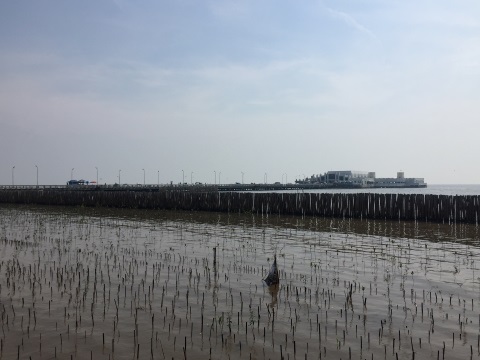
Extending the mangrove belt Besides preventing shoreline erosion, mangrove provides a natural habitat for marine and terrestrial life. It absorbs pollutants from ground water, breaks up dead leaves into nutrients for marine life and serves as a link for marine life to move between off-shore coral reefs to the shore. There's a concrete walkway built through the mangrove to the west of the pier, (it's on the right if you are facing the entrance to the pier). Take a walk along this walkway to view some of the interesting marine life in the mangrove. 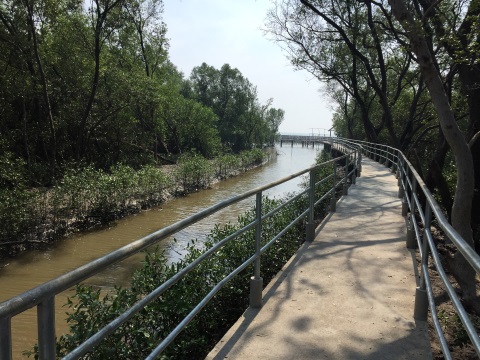
The walkway through the mangrove There are mudskippers, mud crabs, clams, and the occasional long-legged bird hiding among the mangrove. Here's a shot of a mud skipper that's so well blended with its environment, 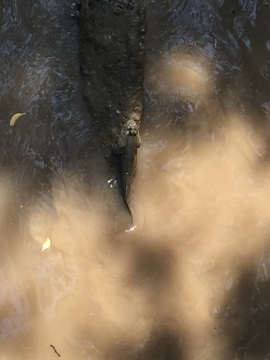
The perfect camouflage 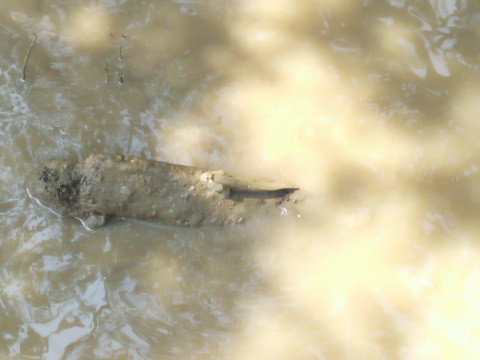
This shot is clearer Unfortunately, the mud crabs were a little too fast, they disappeared into the holes as soon as I tried to photograph them. 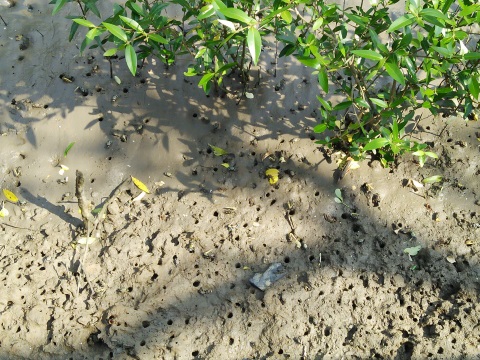
Disappearing mud crabs That brings us to the end of our nature tour this month. Hope you enjoyed it and see you next month. Contents Map to the Bang Pu Resort If the map doesn’t appear, click on this link Address Bang Pu Seaside Resort Sukhumvit Road 37 km Tambon Bang Pu Amphur Muang Samut Prakarn 10280 Tel: +66 2323 1213 Opening times Pier is open from 0500 – 2000 hours The restaurant is open from 1000 – 2000 hours How to get there By car If you are coming from Bangkok or the west, use the Erawan Museum with its huge three-headed elephant as your landmark. Get on to Sukhumvit Road, past the Royal Thai Naval Academy and Ancient City (Mueang Boran) before you get to the Bang Pu Seaside Resort. The resort is within a military area but it's open to the public. By public transport Take the Sukhumvit line to the current terminal station at E15 Samrong, then take a taxi to the resort. The Sukhumvit line extension within eight additional stations is not operational yet. When the extension is fully operational you can alight at E23 Kheha which is even nearer to Bang Pu. Contents Next month Visiting an organic farm and restaurant If you enjoyed reading this e-zine, please forward it to a friend. If you received this from a friend and found it interesting, please subscribe at Bangkok Travelbug. What do you think of the Bangkok Travelbug? We love to hear from you What other subscribers have said Till next month then. Eric Lim Tour Bangkok Legacies Find us on Facebook My Journey through Thailand Part I The First Steps This is my second e-book and the first in the series of travel journals on my trips to explore the various provinces in Thailand. This edition, which covers my travels from late 2009 to mid-2013, will guide you to historical sites, cultural monuments and exquisite Thai handicraft, across a vast spectrum of cultural and ethnic diversity. You can have a virtual tour with this e-guide book or take the first steps yourself in this journey through Thailand. My Kindle e-book 
Copyright@2008-2018 Tour Bangkok Legacies All rights reserved |
| Back to Back Issues Page |
